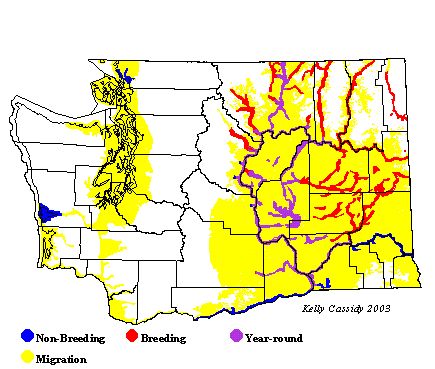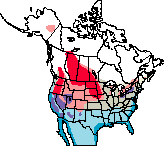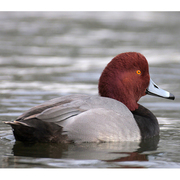Redhead
General Description
Female and juvenile Redheads are brownish-gray overall, with gray legs, black eyes and a gray bill with a black tip. Males in breeding plumage have a gray body, black rump and breast, and a bright rufous head with a yellow eye and a light blue bill with a black tip. The male in non-breeding plumage (from July to September) is overall dark brown, but still has a dull reddish head. Redheads are a little smaller than the similar looking Canvasbacks, with a rounder head, a lighter back, and a more typically duck-shaped bill.
Habitat
Redheads nest on marshy freshwater lakes, ponds, slow moving rivers and other wetlands in prairie zones. During migration they gather on large lakes and they spend the winter on sheltered saltwater bays and estuaries and some inland lakes.
Behavior
Redheads usually gather in small flocks, often mixed with other diving duck species. But in the winter they congregate in very large flocks, made up of tens of thousands of birds. Although they are considered divers, they often feed by dabbling. A notable behavior of the Redhead is their tendency to parasitize, or lay eggs in other duck's nests. Many ducks will lay eggs in each others nests, but the Redhead takes this practice to another level. Female Redheads regularly parasitize each other, and at least ten other species of duck, and some non-duck species as well. Most females parasitize in addition to raising their own brood, but some females may be entirely parasitic, not raising their own brood at all. Sometimes, dump nests occur that are untended and never incubated, but may have up to 87 eggs in them.
Diet
The leaves, stems, seeds and roots of aquatic plants make up the majority of the diet. Many aquatic invertebrates are also eaten, especially in the summer.
Nesting
Nests are located close together in dense marshes, especially areas with dense bulrush, above shallow water or on dry land. The female builds a bulky bowl out of vegetation and, if it is in water, anchors it to some emergent vegetation. The nest is then lined with down. Actual clutch size is difficult to determine due to the Redhead's parasitism, but clutch size usually ranges between 6-14 eggs. The female incubates for about 23-29 days, during which time, the male leaves. About a day after hatching, the female leads the young away from the nest to water, where they feed themselves. The young are capable of flight after 60-65 days.
Migration Status
After pair bonds dissolve the males may fly hundreds of miles north to gather on large lakes and go through a flightless stage. The main migration is fairly early in the fall, peaking in August and September. Spring migration usually lasts from February to May. The Redhead is the only duck that winters in greater numbers in the interior rather than on the coast, and in Washington numbers during migration are heavier in the eastern half of the state than the west.
Conservation Status
Although still a common duck, the total population of Redheads is far below historic levels and they have experienced a sharper decline than most ducks in recent years. Loss of nesting habitat is their greatest threat. Distribution patterns of Redheads changed dramatically during the 20th century and they are now common in some areas where they used to be scarce.
When and Where to Find in Washington
The Redhead is one of the most common ducks east of the Columbia River during the breeding season, although it is less common in much of the southern Columbia Basin. Many spend the winter in eastern Washington, but they are much less common during this season than the breeding season. In western Washington, Redheads are a rare breeder, with two confirmed nesting records west of the Cascades. During fall migration they are uncommon in the west (mid-October to mid-November) and uncommon to rare through the winter (until the end of April).
 Abundance
Abundance
| Ecoregion | Jan | Feb | Mar | Apr | May | Jun | Jul | Aug | Sep | Oct | Nov | Dec |
|---|---|---|---|---|---|---|---|---|---|---|---|---|
| Oceanic | ||||||||||||
| Pacific Northwest Coast | R | R | R | R | R | R | R | R | R | |||
| Puget Trough | R | R | R | R | R | R | R | R | R | R | R | R |
| North Cascades | ||||||||||||
| West Cascades | R | R | R | R | R | R | R | |||||
| East Cascades | U | U | U | U | R | R | R | U | U | U | ||
| Okanogan | U | F | C | C | C | C | C | C | C | C | C | U |
| Canadian Rockies | F | F | F | F | U | U | U | U | F | F | F | F |
| Blue Mountains | R | R | R | R | R | |||||||
| Columbia Plateau | C | C | C | C | C | C | C | C | C | C | C | C |
Washington Range Map

North American Range Map


Family Members
 Fulvous Whistling-DuckDendrocygna bicolor
Fulvous Whistling-DuckDendrocygna bicolor Taiga Bean-GooseAnser fabalis
Taiga Bean-GooseAnser fabalis Greater White-fronted GooseAnser albifrons
Greater White-fronted GooseAnser albifrons Emperor GooseChen canagica
Emperor GooseChen canagica Snow GooseChen caerulescens
Snow GooseChen caerulescens Ross's GooseChen rossii
Ross's GooseChen rossii BrantBranta bernicla
BrantBranta bernicla Cackling GooseBranta hutchinsii
Cackling GooseBranta hutchinsii Canada GooseBranta canadensis
Canada GooseBranta canadensis Mute SwanCygnus olor
Mute SwanCygnus olor Trumpeter SwanCygnus buccinator
Trumpeter SwanCygnus buccinator Tundra SwanCygnus columbianus
Tundra SwanCygnus columbianus Wood DuckAix sponsa
Wood DuckAix sponsa GadwallAnas strepera
GadwallAnas strepera Falcated DuckAnas falcata
Falcated DuckAnas falcata Eurasian WigeonAnas penelope
Eurasian WigeonAnas penelope American WigeonAnas americana
American WigeonAnas americana American Black DuckAnas rubripes
American Black DuckAnas rubripes MallardAnas platyrhynchos
MallardAnas platyrhynchos Blue-winged TealAnas discors
Blue-winged TealAnas discors Cinnamon TealAnas cyanoptera
Cinnamon TealAnas cyanoptera Northern ShovelerAnas clypeata
Northern ShovelerAnas clypeata Northern PintailAnas acuta
Northern PintailAnas acuta GarganeyAnas querquedula
GarganeyAnas querquedula Baikal TealAnas formosa
Baikal TealAnas formosa Green-winged TealAnas crecca
Green-winged TealAnas crecca CanvasbackAythya valisineria
CanvasbackAythya valisineria RedheadAythya americana
RedheadAythya americana Ring-necked DuckAythya collaris
Ring-necked DuckAythya collaris Tufted DuckAythya fuligula
Tufted DuckAythya fuligula Greater ScaupAythya marila
Greater ScaupAythya marila Lesser ScaupAythya affinis
Lesser ScaupAythya affinis Steller's EiderPolysticta stelleri
Steller's EiderPolysticta stelleri King EiderSomateria spectabilis
King EiderSomateria spectabilis Common EiderSomateria mollissima
Common EiderSomateria mollissima Harlequin DuckHistrionicus histrionicus
Harlequin DuckHistrionicus histrionicus Surf ScoterMelanitta perspicillata
Surf ScoterMelanitta perspicillata White-winged ScoterMelanitta fusca
White-winged ScoterMelanitta fusca Black ScoterMelanitta nigra
Black ScoterMelanitta nigra Long-tailed DuckClangula hyemalis
Long-tailed DuckClangula hyemalis BuffleheadBucephala albeola
BuffleheadBucephala albeola Common GoldeneyeBucephala clangula
Common GoldeneyeBucephala clangula Barrow's GoldeneyeBucephala islandica
Barrow's GoldeneyeBucephala islandica SmewMergellus albellus
SmewMergellus albellus Hooded MerganserLophodytes cucullatus
Hooded MerganserLophodytes cucullatus Common MerganserMergus merganser
Common MerganserMergus merganser Red-breasted MerganserMergus serrator
Red-breasted MerganserMergus serrator Ruddy DuckOxyura jamaicensis
Ruddy DuckOxyura jamaicensis

